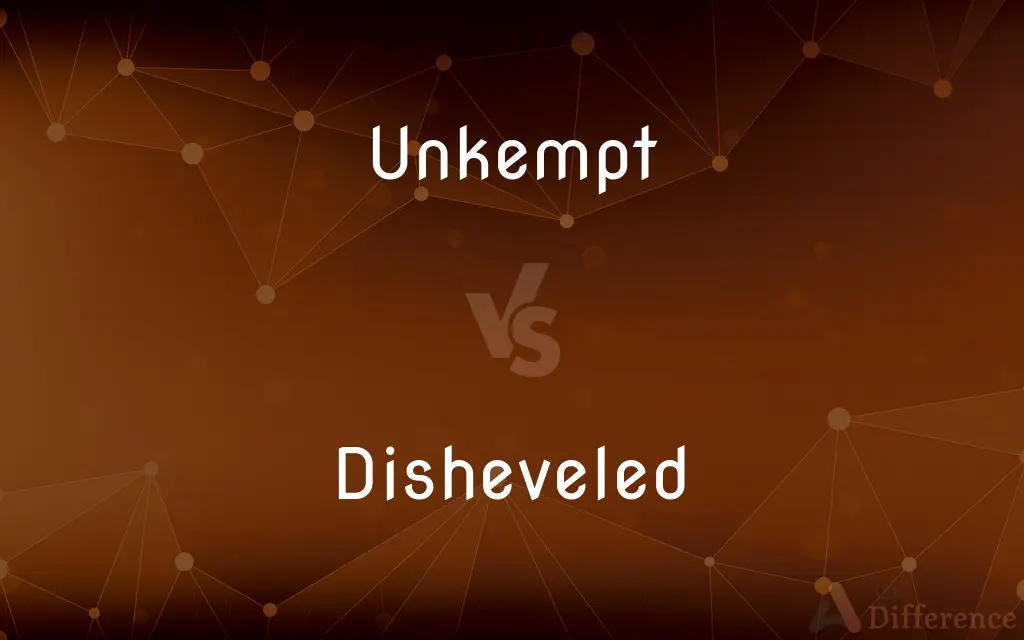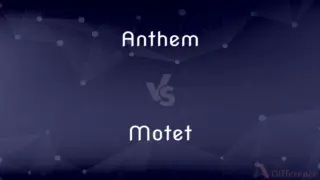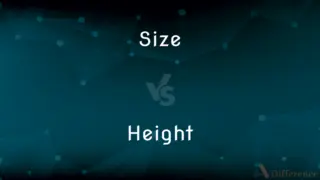Unkempt vs. Disheveled — What's the Difference?
Edited by Tayyaba Rehman — By Urooj Arif — Updated on April 8, 2024
Unkempt refers to a lack of neatness and order in appearance, especially regarding hair or clothing, while disheveled implies a state of disorder or untidiness, often suggesting a more disturbed or hastily altered state.

Difference Between Unkempt and Disheveled
Table of Contents
ADVERTISEMENT
Key Differences
Unkempt generally describes an overall appearance of neglect or lack of care, particularly in the context of personal grooming or the tidiness of one's attire. It often conveys a persistent state, not necessarily resulting from a recent activity or situation. On the other hand, disheveled usually pertains to a more specific, often temporary, state of disorder or untidiness, as if one has been physically disturbed or hastily active, resulting in a noticeably ruffled or disordered appearance.
While "unkempt" can apply broadly to environments, gardens, or even lifestyles, indicating a sustained lack of attention or maintenance, "disheveled" is more commonly used to describe someone's physical appearance, especially their hair or clothes, after some sort of activity or event. This distinction underscores the temporal or situational aspects of disheveled compared to the more chronic implication of unkempt.
The term "unkempt" might suggest a habitual condition, such as consistently neglecting personal grooming or cleanliness, reflecting on an individual's habits or circumstances. In contrast, being described as "disheveled" could imply a recent encounter or exertion, such as being caught in the rain or rushing to get dressed, which temporarily disrupts one's polished appearance.
Both unkempt and disheveled carry connotations of social perception and standards. However, being unkempt might be viewed as a choice or consequence of one’s actions over time, suggesting a deeper narrative about personal care or priorities. Conversely, appearing disheveled might elicit more immediate concerns or assumptions about one’s current state or activities, indicating a departure from an individual's usual demeanor or appearance due to recent events.
Despite their nuances, in everyday language, both terms are often used interchangeably when referring to someone’s messy or untidy state. However, the choice between them can convey subtle differences in meaning, reflecting the speaker's perception of the nature and cause of the disarray.
ADVERTISEMENT
Comparison Chart
Definition
Lacking neatness and order, often due to neglect
Disorderly or untidy, especially from being disturbed
Common Usage
Hair, clothing, personal grooming
Specifically refers to hair or clothing after disturbance
Implication
Suggests a habitual or persistent state
Indicates a temporary or recent state
Context
Can apply to broader situations beyond personal appearance
Primarily used for physical appearance
Social Perception
May suggest long-term neglect or lifestyle choices
Often seen as a result of recent activities or mishaps
Compare with Definitions
Unkempt
Indicative of a neglectful or carefree lifestyle.
His unkempt appearance belied a sharp mind.
Disheveled
Temporary untidiness, as opposed to a habitual state.
Despite his usually neat appearance, today he looked disheveled.
Unkempt
Showing a lack of care or neglect.
The unkempt garden was overgrown with weeds.
Disheveled
Untidy, disordered, especially of clothing or hair.
He arrived at the meeting looking disheveled, his coat drenched from the rain.
Unkempt
Not combed; untidy; not properly maintained; disorderly.
His unkempt beard and hair gave him a rugged look.
Disheveled
Reflecting a state of disturbance or haste.
Her disheveled appearance suggested she had rushed there.
Unkempt
Reflecting a lack of order or cleanliness in appearance or surroundings.
Her desk was as unkempt as her hastily tied back hair.
Disheveled
Often associated with a recent activity or mishap.
After the long flight, everyone looked a bit disheveled.
Unkempt
Often used more broadly beyond personal grooming.
The once-loved house now stood unkempt and abandoned.
Disheveled
Pertaining to a specific incident causing disorder.
The wind left her hair disheveled and her papers scattered.
Unkempt
(especially of a person) having an untidy or dishevelled appearance
They were unwashed and unkempt
Disheveled
Being in loose disarray; unkempt, as hair or clothing.
Unkempt
Not combed
Unkempt hair.
Disheveled
Marked by disorder; untidy
A disheveled pile of books on the library table.
Unkempt
Disorderly or untidy in appearance
An unkempt vagabond.
An unkempt garden.
Disheveled
Alternative form of dishevelled
Unkempt
(of hair) Uncombed; dishevelled.
Disheveled
Simple past tense and past participle of dishevel
Unkempt
(by extension) Disorderly; untidy; messy; not kept up.
Unkempt bedroom
Disheveled
Hanging in loose disorder; disarranged; in disarray; not made neat; - used especially of hair or clothing; as, disheveled hair.
Unkempt
(figurative) Rough; unpolished
Disheveled
Having the hair in loose disorder.
The dancing maidens are disheveled Mænads.
Unkempt
Not combed; disheveled; as, an urchin with unkempt hair.
Disheveled
In disarray; extremely disorderly;
Her clothing was disheveled
Powder-smeared and frowzled
A rumpled unmade bed
A bed with tousled sheets
His brown hair was tousled, thick, and curly
Unkempt
Fig.; Not smoothed; unpolished; rough.
My rhymes be rugged and unkempt.
Unkempt
Not neatly combed;
Wild unkempt hair
Unkempt
Not neat or cared for; slovenly;
His unkempt appearance
Unkempt
Not properly maintained;
An unkempt garden
Native vistas and unkempt rambling paths
Common Curiosities
What is the difference between unkempt and disheveled?
Unkempt implies a general, possibly habitual lack of care or grooming, while disheveled suggests a temporary state of untidiness resulting from recent activity or disturbance.
Can a place be described as disheveled?
Typically, "disheveled" is used to describe a person's appearance, but it can be applied metaphorically to places in a state of disorder due to recent events.
Is being unkempt always a choice?
Not necessarily. While sometimes it might reflect personal choices or lifestyle, it can also result from circumstances beyond one’s control.
How does society view unkempt vs. disheveled appearances?
Society may view unkempt appearances as indicative of neglect or lifestyle choices, whereas disheveled appearances are often seen as temporary and less indicative of personal habits.
What impact does a disheveled appearance have in professional settings?
In professional settings, a disheveled appearance might negatively impact one’s perceived competence and professionalism, although context and industry norms can vary.
What does unkempt mean?
Unkempt describes a lack of neatness and order, especially in personal appearance, indicating neglect or lack of care.
How do personal grooming habits influence perceptions of unkemptness?
Personal grooming habits greatly influence perceptions of unkemptness, with consistent care often mitigating negative judgments.
Can someone be unkempt and disheveled at the same time?
Yes, someone can be generally unkempt as part of their habitual appearance and also look disheveled due to a recent event or activity.
Do cultural differences affect the perception of being unkempt or disheveled?
Yes, cultural norms and values significantly influence what is considered unkempt or disheveled, with varying standards for personal appearance.
How can one transition from an unkempt to a neat appearance?
Transitioning to a neat appearance involves regular grooming, maintaining cleanliness, and choosing attire that reflects care and attention.
Is it possible for an unkempt appearance to be fashionable?
In certain contexts and fashion trends, what might traditionally be considered unkempt (e.g., tousled hair) can be seen as stylish or intentional.
Can an unkempt or disheveled appearance affect mental health?
Yes, the state of one’s appearance can reflect and affect mental health, with neglect possibly signaling underlying issues, and improving appearance potentially boosting self-esteem.
What role does personal hygiene play in being considered unkempt or disheveled?
Personal hygiene is crucial; poor hygiene can contribute to being perceived as unkempt, while good hygiene can prevent a disheveled look from reflecting negatively on overall cleanliness.
Share Your Discovery

Previous Comparison
Anthem vs. Motet
Next Comparison
Size vs. HeightAuthor Spotlight
Written by
Urooj ArifUrooj is a skilled content writer at Ask Difference, known for her exceptional ability to simplify complex topics into engaging and informative content. With a passion for research and a flair for clear, concise writing, she consistently delivers articles that resonate with our diverse audience.
Edited by
Tayyaba RehmanTayyaba Rehman is a distinguished writer, currently serving as a primary contributor to askdifference.com. As a researcher in semantics and etymology, Tayyaba's passion for the complexity of languages and their distinctions has found a perfect home on the platform. Tayyaba delves into the intricacies of language, distinguishing between commonly confused words and phrases, thereby providing clarity for readers worldwide.














































